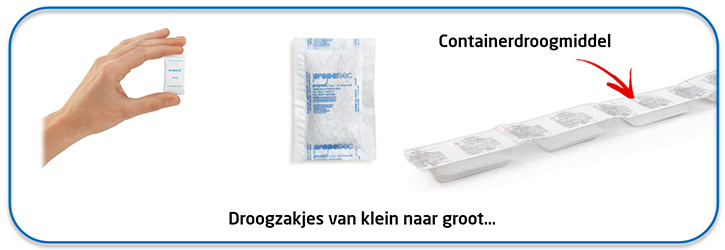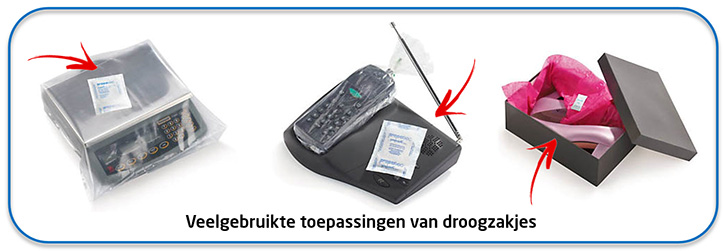Rain, water, moisture… We can usually miss it like a toothache. And the same goes for your packaging. Depending on the goods you ship, it is interesting, or even essential, to use dry bags. They are an extra guarantee that your products reach their final destination in good condition. Read here how best to use these bags.
1. What are dryer bags?
Dry bags have 1 main purpose: to absorb water. You often find them in packaging containing food or clothing. They keep your products from getting damaged by moisture or corrosion.
Drying bags come in many different sizes. There are small bags only a few centimetres wide that are hardly noticeable. But there are also large drying bags that are hung in a container by chain. They keep the humidity inside the container low enough to safely transport your goods by sea or rail.

2. How do dryer bags work?
The dehydrating properties of these pouches can be attributed to two important minerals: clay and silica gel.
► Clay is the most economical and environmentally friendly desiccant. It is a 100% natural substance and therefore non-toxic. Clay used for these purposes has a high attraction to moisture. Unlike silica gel, clay also offers good protection against a second culprit: corrosion. As a result, clay is most often used in these sectors:
- Mechanics,
- Maritime transport.
► Silica gel in turn is an artificially developed desiccant first patented in 1919 in US Baltimore, Maryland. It is not in fact a gel, but a fine grain of silica. Silica gel is currently the desiccant with the highest moisture absorbing capacity on the market. Even when saturated with moisture, these desiccant bags still feel dry to the touch. Silica gel is used among other things in shipping:
- Clothing,
- Pharmaceuticals,
- Foodstuffs,
- Electronics.
 ]
]
3. How to use dryer bags?
The amount of desiccant bags depends on the size of your packaging: the bigger the box and the product, the more desiccant you need. To ensure the desiccant works properly, it is also advisable to put your product in a foil or bag that can be made airtight. Clay and silica gel-based desiccant bags are reusable, by the way. So after 1 transport, you can simply use the pouch from one packaging into another.
Should a silica gel bag still be wet and damp, you can easily reuse it by heating it in a dish between +120 °C and +150 °C for an hour. Its moisture-absorbing properties will then be as good as new again!
]4. Where else does desiccant come in handy?
We have already talked here about the use of desiccants in packaging. But their first applications were elsewhere. Silica gel, for example, was first widely used during World War II. At the time, the US army used it to keep penicillin dry. But history has taught us that you can do a lot more with them. You can also use them to:
- eliminate bad odours in a room;
- keep the clothes in your closet dry;
- prevent condensation on windows;
- prevent the growth of bacteria and mould in the bathroom or in a gym bag;
- keep food fresh for longer;
- preserve the glory of old photos.
And should your smartphone have fallen into the water… No worries! Because even then, drying bags with silica gel are again the ideal remedy. So is there a bag of silica gel in the next webshop pack you receive? Then keep it from now on, because as you can see, it still comes in handy elsewhere in the house.

- There are 2 types of minerals for dryer bags: clay and silica gel.
- Both materials are non-toxic and hold water very well.
- Silica gel bags are easy to reuse after you heat them for 1 hour. They are applicable to numerous places in your home.














